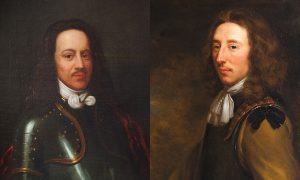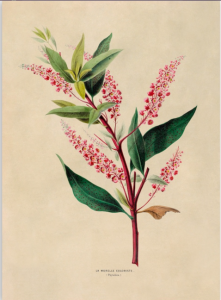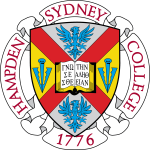The Name, Hampden-Sydney College

The first president, Samuel Stanhope Smith (1775–1779), chose the name Hampden-Sydney to symbolize devotion to the principles of representative government and full civil and religious freedom, which the Englishmen John Hampden (1594–1643) and Algernon Sidney* (1622–1683) had supported and for which they had given their lives. They were widely invoked as hero-martyrs by American colonial patriots, and their names immediately associated the College with the cause of independence championed by Patrick Henry, James Madison, and the other less well-known but equally vigorous patriots who comprised the College’s first Board of Trustees.
*An “i” or a “y”
In the 1775 Virginia Gazette, Samual Stanhope Smith announced the opening of Hampden-Sidney. The 1783 seal, created at the time the charter was granted, uses Sidney. Algernon Sidney, like his uncle Sir Philip Sidney (1554-1586), author and statesman, favored an “i”. Clearly the “i” spelling was favored during the 16th, 17th and 18th Centuries. In the 19th Century, the “y” spelling became popular. Wherever one encounters the name in Australia, the “y” is used. The College spelled its name both ways until the 1930s when Sydney was made standard.
The Mission
“To form good men and good citizens” was the original mission of Hampden-Sydney College established by the Founders in 1775. “In an atmosphere of sound learning” first appeared in the Academic Catalogue in 1972. Together they constitute the College’s current mission.
The Motto
The Latin motto on the College gates is translated: “Come here as youths so that you may leave as men.”
In ancient Rome a male was considered a boy (puer) until he was 14, at which time he was designated a youth (juvenis). With this status, a youth acquired every legal capacity that depended on age alone, with the exception of the capacity for public office. The youth could contract marriage, thus becoming a paterfamilias; he was also liable to military service and entitled to vote in the comitia. However, youths were also given some special legal protections.

The Colors
The first students committed themselves to the revolutionary effort, organized a militia-company, drilled regularly, and went off to the defense of Williamsburg in 1777 and Petersburg in 1778. Their uniform was a hunting-shirt, dyed purple with the juice of pokeberries, and gray trousers. Garnet and gray were adopted as the College’s colors when sports teams were introduced in the 19th century.
The College Seal
The College Seal symbolically combines liberty, religion, and academics to produce the formula for a successful college career.
In 1783, a seal was authorized for Hampden-Sydney, “to be engraved with proper devices,” for use on the diplomas of her graduates. The die for the seal was first engraved in 1784.  The seal is a circle divided into three sections: an upper half and two lower quadrants. Though the figures within the seal have been changed somewhat since the original, the symbolism still exists.
The seal is a circle divided into three sections: an upper half and two lower quadrants. Though the figures within the seal have been changed somewhat since the original, the symbolism still exists.
- In the lower right-hand corner, there is an orator, presumably a preacher.
- In the lower left-hand quadrant, there is a man kneeling on a rock in front of an open book (originally the word “Liberty” appeared below the book, but has since been deleted).
- In the top half of the seal, on the right side, there is a table with books on it. On the left side, there is a flask (the laboratory kind) with a ribbon around the neck, and a rolled-up diploma.
- The original seal had no date. The 1776 was added at the time of the bicentennial.
The Coat of Arms
 Through the generosity of the F.M. Kirby Foundation, Inc., the College was able to secure an authentic coat of arms and other “armorial bearings” from the College of Arms, an office of the Royal Household, as part of the bicentennial celebration, 1972-76. The Kirby Foundation has designated the “achievement of arms” a gift in honor of Professor John Brinkley 1959, who was the liaison with Mr. John Brooke-Little, then the Richmond Herald, in designing the arms.
Through the generosity of the F.M. Kirby Foundation, Inc., the College was able to secure an authentic coat of arms and other “armorial bearings” from the College of Arms, an office of the Royal Household, as part of the bicentennial celebration, 1972-76. The Kirby Foundation has designated the “achievement of arms” a gift in honor of Professor John Brinkley 1959, who was the liaison with Mr. John Brooke-Little, then the Richmond Herald, in designing the arms.
The specifications of the arms can be simplified from the arcane language of “blazon.”
- On either side there are two blue pheons (particularly nasty arrowheads or spearheads) against a gold background—this feature is from the Sydney arms.
- At top and bottom are blue eagles against a silver background—this feature is from the Hampden arms.
- The Hampden and Sydney quarters are separated by a red saltire (St. Andrew’s cross), representing the Church of Scotland.
- In the middle is the College’s unique device, an open Bible with the Greek words of John 8:32 (“Ye shall know the truth”).
Expectations of Hampden-Sydney Students
At Hampden-Sydney College, all students are expected to abide by our two governing statements, the Honor Code and the Code of Student Conduct, about which each and every student is educated and by which he swears to abide on his very first day on campus.
